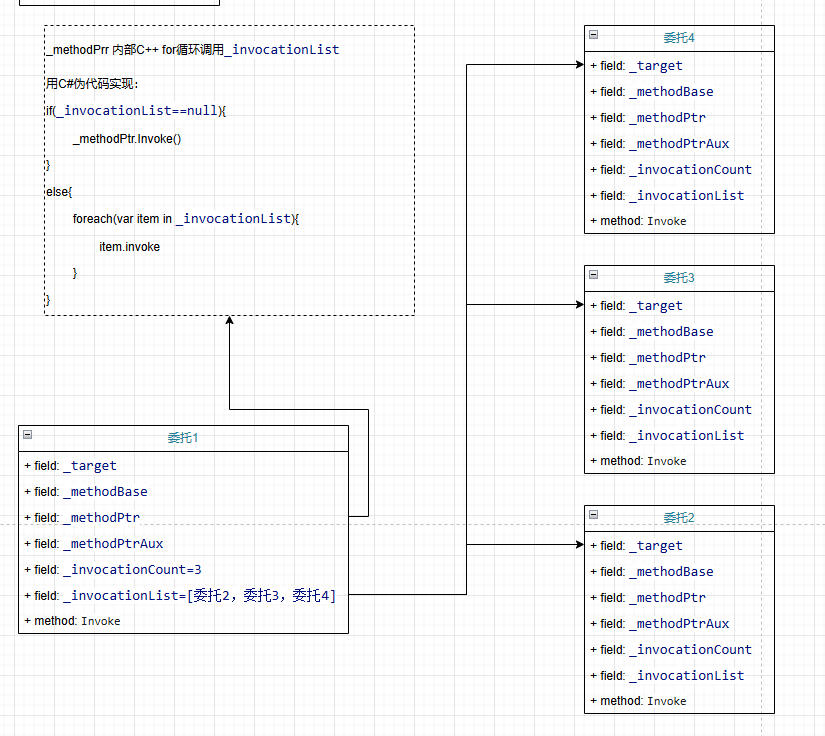.NET Core 委托(Delegate)底层原理浅谈
简介
.NET通过委托来提供回调函数机制,与C/C++不同的是,委托确保回调是类型安全,且允许多播委托。并支持调用静态/实例方法。
简单来说,C++的函数指针有如下功能限制,委托作为C#中的上位替代,能弥补函数指针的不足。
- 类型不安全
函数指针可以指向一个方法定义完全不同的函数。在编译期间不检查正确性。在运行时会导致签名不同导致程序崩溃 - 只支持静态方法
只支持静态方法,不支持实例方法(只能通过邪道来绕过) - 不支持方法链
只能指向一个方法定义
函数指针与委托的相似之处
函数指针
typedef int (*func)(int, int);
委托
delegate int func(int a, int b);
委托底层模型

delegate关键字作为语法糖,IL层会为该关键字自动生成Invoke/BeginInvoke/EndInvoke方法,在.NET Core中,不再支持BeginInvoke/EndInvoke
眼见为实
public abstract partial class Delegate : ICloneable, ISerializable
{
// _target is the object we will invoke on
internal object? _target; // 源码中的注释不太对(null if static delegate)。应该是这样:如果注册的是实例方法,则是this指针,如果是静态则是delegate实例自己。
// MethodBase, either cached after first request or assigned from a DynamicMethod
// For open delegates to collectible types, this may be a LoaderAllocator object
internal object? _methodBase; //缓存
// _methodPtr is a pointer to the method we will invoke
// It could be a small thunk if this is a static or UM call
internal IntPtr _methodPtr;//实例方法的入口,看到IntPtr关键字就知道要与非托管堆交互,必然就是函数指针了,
// In the case of a static method passed to a delegate, this field stores
// whatever _methodPtr would have stored: and _methodPtr points to a
// small thunk which removes the "this" pointer before going on
// to _methodPtrAux.
internal IntPtr _methodPtrAux;//静态方法的入口
}
public abstract class MulticastDelegate : Delegate
{
//多播委托的底层基石
private object? _invocationList;
private nint _invocationCount;
//实例委托调用此方法
private void CtorClosed(object target, IntPtr methodPtr)
{
if (target == null)
ThrowNullThisInDelegateToInstance();
this._target = target;
this._methodPtr = methodPtr;//函数指针被指向_methodPtrAux
}
//静态委托调用此方法
private void CtorOpened(object target, IntPtr methodPtr, IntPtr shuffleThunk)
{
this._target = this;//上面说到,_target的注释不对的判断就在此
this._methodPtr = shuffleThunk;//与实例委托不同,这里被指向一个桩函数
this._methodPtrAux = methodPtr;//函数指针被指向_methodPtrAux
}
}
委托如何同时支持静态方法与实例方法?
示例代码
static void Main(string[] args)
{
//1.注册实例方法
MyClass myObject = new MyClass();
MyDelegate myDelegate2 = new MyDelegate(myObject.InstanceMethod);
myDelegate2.Invoke("Hello from instance method");
Debugger.Break();
//2.注册静态方法
MyDelegate myDelegate = MyClass.StaticMethod;
myDelegate.Invoke("Hello from static method");
Debugger.Break();
}
}
public delegate void MyDelegate(string message);
public class MyClass
{
public static void StaticMethod(string message)
{
Console.WriteLine("Static Method: " + message);
}
public void InstanceMethod(string message)
{
Console.WriteLine("Instance Method: " + message);
}
}
myDelegate2.Invoke("Hello from instance method");
00007ff9`521a19bd 488b4df0 mov rcx,qword ptr [rbp-10h]
00007ff9`521a19c1 48baa0040000c7010000 mov rdx,1C7000004A0h ("Hello from instance method")
00007ff9`521a19cb 488b4908 mov rcx,qword ptr [rcx+8]
00007ff9`521a19cf 488b45f0 mov rax,qword ptr [rbp-10h]
00007ff9`521a19d3 ff5018 call qword ptr [rax+18h] //重点
00007ff9`521a19d6 90 nop
myDelegate.Invoke("Hello from static method");
00007ff9`521a1a54 488b4de8 mov rcx,qword ptr [rbp-18h]
00007ff9`521a1a58 48baf0040000c7010000 mov rdx,1C7000004F0h ("Hello from static method")
00007ff9`521a1a62 488b4908 mov rcx,qword ptr [rcx+8]
00007ff9`521a1a66 488b45e8 mov rax,qword ptr [rbp-18h]
00007ff9`521a1a6a ff5018 call qword ptr [rax+18h] //重点
00007ff9`521a1a6d 90 nop
可以看到,静态与实例都指向了rax+18h的地址偏移量。那么+18到底指向哪里呢?

Invoke的本质就是调用_methodPtr所在的函数指针
那么有人就会问了,前面源码里不是说了。静态方法的入口不是_methodPtrAux吗?怎么变成_methodPtr了。
实际上,如果是静态委托。JIT会生成一个桩方法,桩方法内部调用会+20偏移量的内容。从而调用_methodPtrAux
实例与静态核心代码的差异,大家有兴趣的话可以看一下它们的汇编
- 实例方法核心代码
private void CtorClosed(object target, nint methodPtr)
{
if (target == null)
{
ThrowNullThisInDelegateToInstance();
}
_target = target;
_methodPtr = methodPtr;//_methodPtr真正承载了函数指针
}
- 静态方法核心代码
private void CtorOpened(object target, nint methodPtr, nint shuffleThunk)
{
_target = this;
_methodPtr = shuffleThunk;//_methodPtr只是一个桩函数
_methodPtrAux = methodPtr;//真正的指针在_methodPtrAux中
}
委托如何支持类型安全?
点击查看代码
internal class Program
{
static void Main(string[] args)
{
//1. 编译器层面错误
//var myDelegate = new MyDelegate(Math.Max);
//2. 运行时层类型转换错误
var myDelegate = new MyDelegate(Console.WriteLine);
MyMaxDelegate myMaxDelegate = (MyMaxDelegate)(object)myDelegate;
Debugger.Break();
}
public delegate void MyDelegate(string message);
public delegate int MyMaxDelegate(int a, int b);
}
-
编译器层会拦截
这个很简单,在编译器中如果定义不匹配就会报错。

-
CLR Runtime会在汇编中插入检查命令
检查不一致会报错,不至于整个程序奔溃。

委托如何支持多播?

多播委托的添加
委托使用+=或者Delegate.Combine来添加新的委托。其底层调用的是CombineImpl,由子类MulticastDelegate实现。
并最终产生一个新的委托
for循环1000次Combine委托,会产生1000个对象,
//简化版
protected sealed override Delegate CombineImpl(Delegate? follow)
{
MulticastDelegate dFollow = (MulticastDelegate)follow;
object[]? resultList;
int followCount = 1;
object[]? followList = dFollow._invocationList as object[];
if (followList != null)
followCount = (int)dFollow._invocationCfollowListount;
int resultCount;
if (!(_invocationList is object[] invocationList))
{
resultCount = 1 + followCount;
resultList = new object[resultCount];
resultList[0] = this;
if (followList == null)
{
resultList[1] = dFollow;
}
else
{
for (int i = 0; i < followCount; i++)
resultList[1 + i] = followList[i];
}
return NewMulticastDelegate(resultList, resultCount);
}
//xxxxxxxxxx
}
//关键核心,将组合后的Delegate组成一个新对象,并填充invocationList,invocationCount
private MulticastDelegate NewMulticastDelegate(object[] invocationList, int invocationCount, bool thisIsMultiCastAlready)
{
// First, allocate a new multicast delegate just like this one, i.e. same type as the this object
MulticastDelegate result = (MulticastDelegate)InternalAllocLike(this);
// Performance optimization - if this already points to a true multicast delegate,
// copy _methodPtr and _methodPtrAux fields rather than calling into the EE to get them
if (thisIsMultiCastAlready)
{
result._methodPtr = this._methodPtr;
result._methodPtrAux = this._methodPtrAux;
}
else
{
result._methodPtr = GetMulticastInvoke();
result._methodPtrAux = GetInvokeMethod();
}
result._target = result;
result._invocationList = invocationList;
result._invocationCount = invocationCount;
return result;
}
多播委托的执行
上面提到,Invoke的本质就是调用_methodPtr所在的函数指针.
那么自然而然,负责执行多播肯定就是_methodPtr了。
从上面的源码可以知道,MulticastDelegate在初始化的时候要调用一次GetMulticastInvoke(),让我们来看看它是什么?

哦豁,它还是一个非托管的方法,有兴趣的同学可以自行查看coreclr的c++源码。奥秘就在其中,本人水平有限,怕误人子弟。
简单来说,就是_methodPtr方法在coreclr底层,for循环执行invocationList的委托队列。
思考一个问题,如果只是一个简单的for循环,其中一个委托卡死/执行失败,怎么办?
提示:MulticastDelegate类中有很多override method
非托管委托(函数指针)
C#作为C++的超集,也别名为C++++ 。也可以说是C++的手动挡(JAVA是C++的自动挡)。
自然而然,C++有的,C#也要有。因此在C#11中引入了函数指针,性能更强的同时也继承了C++的所有缺点(除了会在编译期间协助类型安全检查).
https://learn.microsoft.com/zh-cn/dotnet/csharp/language-reference/unsafe-code#function-pointers
泛型委托
为了减轻你工作量,避免创建太多委托定义。BCL提供了Action/Func来提供便利,减少你的代码量。

它们在底层与delegate并无区别

Lambda表达式
泛型委托是Lambd的基石,其底层还是委托那套东西
var list = new List<string>();
var w= list.Where(x => x.Length > 100);

题外话:Lambda带来的闭包问题
闭包在JS中非常常见,究其原因是因为JS没有变量作用域。导致读取其他函数内部变量的函数,因此在特定情况下会引发bug,特别是在异步与循环中
public static void Method1()
{
var age = 35;
Action action = new Action(() =>
{
Console.WriteLine($"你今年多少岁了?{age}岁");
});
age = 40;
action();
}
public static void Method2()
{
List<Action> list=new List<Action>();
for ( int i = 0; i < 3; i++ )
{
list.Add(new Action(() => { Console.WriteLine($"当前i为{i}"); }));
}
foreach ( Action action in list )
{
action();
}
}
输出结果为:

究其原因,就是当闭包方法a执行时,如果它引用着其它函数b的变量。那么方法a会保留方法b最后执行的变量内容。所以输出结果与正常非闭包方法不一致。
眼见为实
上IL代码

IL代码中,先将35传递给委托方法,再40传递给委托方法,最后再执行invoke.
可以简单抽象为如下代码:
var dc = new DisplayClass2_0() { age = 35 };
Action action = dc.UpdateCase_b__0;
dc.age = 40;
action();
如何解决闭包?
- 用魔法对抗魔法
static void UpdateCaseNew()
{
//1. 用魔法对抗魔法
int age = 35;
int classage = age; //魔法语句 (让它作为类变量)
Action action = () => Console.WriteLine($"你今年多少岁了?{classage}岁");
age = 40;
action();
}
- 避免闭包,使用参数传递.
static void UpdateCaseNew2()
{
int age = 35;
Action<int> action = new Action<int>(x =>
{
Console.WriteLine("{0}岁了,大龄啦!", x);
});
age = 40;
action(35);
}
事件与委托的关系
CLR事件模型以委托为基础,它们之间的关系。像是对委托的进一步封装。
- 事件就是一个语法糖,自己自身并没有新概念
- 委托和事件的关系”等同于“字段和属性的关系”

事件作为语法糖,IL会在底层生成一个委托并提供add_xxxx与remove_xxxx方法对委托进行封装。

实际上在底层,还是操作Delegate.Combine那一套东西



